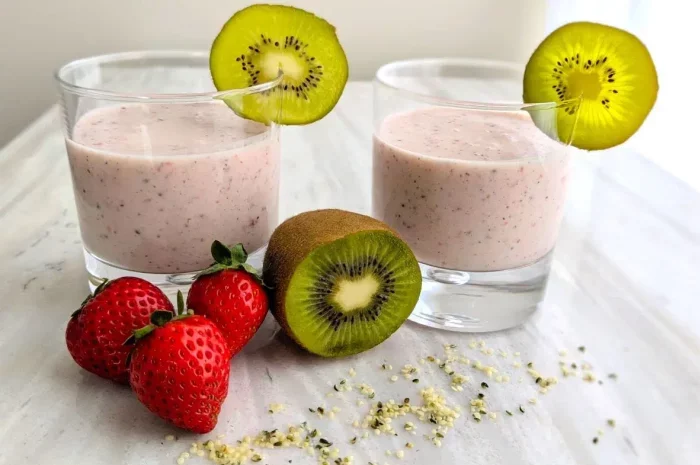Smoothies are a popular, convenient way to pack a nutritious punch. Whether you’re looking to fuel your body after a workout, enjoy a light breakfast, or simply need a tasty snack, the right liquid base is essential for the perfect smoothie. The liquid you choose affects both the taste and texture of the smoothie. So, what liquid should you put in your smoothie? Let’s explore all the options in detail, including the benefits of each.
1. Water: The Most Basic Option
Water is often overlooked but is one of the simplest and healthiest options for your smoothie. It keeps the calorie count low and hydrates your body without adding extra sugars or fats. Water also helps to bring all the ingredients together, ensuring a smooth consistency.
Benefits of Using Water in a Smoothie
Hydration: Water hydrates you, which is essential for overall health.
No Calories: If you’re counting calories, water is a zero-calorie option.
Neutral Taste: It doesn’t overpower the flavors of your fruits or vegetables.
How to Use Water in Smoothies
To use water in your smoothie, simply add a cup or more, depending on how thick or thin you prefer your smoothie. If you want a thicker smoothie, start with a small amount of water and increase it gradually.
2. Almond Milk: A Creamy Dairy-Free Alternative
Almond milk has gained popularity in recent years, especially among people who are lactose intolerant or follow a vegan diet. It has a subtle, nutty flavor that complements many smoothie recipes, especially those with fruits like bananas, berries, or apples.
Benefits of Using Almond Milk in Smoothies
Low in Calories: Unsweetened almond milk is a great option for people trying to reduce calorie intake.
Rich in Vitamin E: Almond milk is rich in vitamin E, which acts as an antioxidant.
Dairy-Free: It’s perfect for those avoiding dairy or those who are lactose intolerant.
How to Use Almond Milk in Smoothies
Almond milk works best in smoothies that need a creamy texture. Add a cup or more of almond milk to your smoothie mixture, depending on your desired thickness. You can also choose between sweetened or unsweetened almond milk, depending on your preference.
3. Coconut Water: A Refreshing Hydration Option
Coconut water has a light, refreshing taste that makes it a perfect liquid base for smoothies, especially tropical ones. Packed with electrolytes, it’s a great option for rehydration after exercise.
Benefits of Using Coconut Water in Smoothies
Hydrates and Replenishes: Coconut water is rich in potassium and electrolytes, making it an excellent choice for hydration.
Low Calorie: It has fewer calories than other liquids like fruit juices or milk.
Natural Flavor: It adds a subtle tropical flavor to your smoothies.
How to Use Coconut Water in Smoothies
Coconut water can be used in almost any type of smoothie. If you’re making a smoothie with tropical fruits like pineapple, mango, or banana, coconut water pairs wonderfully with them. Add it gradually to adjust the consistency, especially if you want to maintain a thicker smoothie.
4. Greek Yogurt: For a Creamy and Protein-Packed Smoothie
Greek yogurt adds a creamy texture to your smoothie while providing a rich source of protein and probiotics. If you want to make your smoothie a more filling meal, Greek yogurt is a great option. It’s especially useful for breakfast smoothies.
Benefits of Using Greek Yogurt in Smoothies
High in Protein: Greek yogurt is a good source of protein, which helps keep you full longer.
Probiotics for Gut Health: It contains probiotics that can improve digestion.
Creamy Texture: It makes your smoothie thicker and richer in texture.
How to Use Greek Yogurt in Smoothies
Use half a cup to a full cup of Greek yogurt, depending on how creamy and filling you want your smoothie. You can also mix Greek yogurt with another liquid, like almond milk or coconut water, to get the best of both worlds.
5. Oat Milk: A Thick and Smooth Alternative
Oat milk has a naturally creamy consistency, making it a great option for those looking to add thickness and richness to their smoothies. It’s also a popular choice for people with nut allergies.
Benefits of Using Oat Milk in Smoothies
Naturally Sweet: Oat milk has a mild, naturally sweet taste that complements many smoothie ingredients.
Gluten-Free: It’s a good option for people with gluten sensitivity, as long as it’s labeled gluten-free.
Vegan and Dairy-Free: Like almond milk, oat milk is plant-based and dairy-free.
How to Use Oat Milk in Smoothies
Oat milk can be used in any smoothie recipe, especially those with oats, bananas, or berries. Its creamy texture helps create a rich and smooth consistency, making it a popular choice for both smoothies and coffee drinks. Add a cup or more depending on your preference.
6. Fruit Juice: Sweet and Flavorful Liquid Base
Fruit juice is one of the most common liquids used in smoothies. It adds a burst of natural sweetness and flavor to the mix. Common choices include orange juice, apple juice, and pineapple juice. However, it’s important to note that fruit juice often contains added sugar, so it’s best to choose 100% pure juice or freshly squeezed juice.
Benefits of Using Fruit Juice in Smoothies
Sweetens Naturally: Fruit juice adds sweetness without needing any added sugars.
Rich in Vitamins: Fruit juices like orange juice are rich in vitamin C, which supports your immune system.
Flavorful: It brings a refreshing and fruity flavor to your smoothie.
How to Use Fruit Juice in Smoothies
Start with half a cup of juice and adjust to taste. Depending on the fruits you’re using in your smoothie, different juices will complement them better. For instance, orange juice pairs well with berries, while pineapple juice is a great match for tropical smoothies.
7. Cashew Milk: A Smooth and Mild Option
Cashew milk is another nut milk alternative that is particularly smooth and mild in flavor. It’s ideal for those who want a creamy, less nutty taste than almond milk.
Benefits of Using Cashew Milk in Smoothies
Low in Calories: Like other nut milks, cashew milk is low in calories, especially the unsweetened variety.
Creamy Texture: It’s naturally creamy, making it perfect for smoothies.
Rich in Nutrients: It contains healthy fats and vitamins like vitamin E.
How to Use Cashew Milk in Smoothies
Cashew milk works well in both fruit and vegetable-based smoothies. Add it gradually to reach your desired texture. It also blends seamlessly with protein powders, greens, and other smoothie additives.
8. Milk: The Classic Option
Regular cow’s milk is one of the most common liquids used in smoothies. It’s creamy, rich, and offers a good balance of protein, calcium, and fat.
Benefits of Using Cow’s Milk in Smoothies
Protein-Rich: Cow’s milk provides protein that helps build and repair muscles.
Rich in Calcium: It’s an excellent source of calcium for strong bones and teeth.
Filling: The fat content in whole milk can make your smoothie more filling and satisfying.
How to Use Milk in Smoothies
Cow’s milk can be used in almost any type of smoothie. If you want a richer, creamier smoothie, opt for whole milk. For a lighter version, use skim or 2% milk. Add the milk gradually to control the smoothie’s consistency.
9. Soy Milk: A Protein-Packed Plant-Based Option
Soy milk is a plant-based milk that provides a protein content similar to cow’s milk. It’s a great option for people who are lactose intolerant or follow a vegan diet.
Benefits of Using Soy Milk in Smoothies
High in Protein: Soy milk is rich in protein, making it a great option for muscle repair and recovery.
Dairy-Free: It’s a suitable alternative for those avoiding dairy.
Rich in Nutrients: It contains essential vitamins and minerals, including vitamin D, B12, and calcium.
How to Use Soy Milk in Smoothies
Soy milk blends well in a variety of smoothies, especially those with protein powders. Add a cup of soy milk to your smoothie base and mix well. The mild flavor won’t overpower other ingredients.
10. Coconut Milk: For a Rich, Tropical Flavor
Coconut milk adds a thick, creamy texture with a rich, tropical flavor. It’s different from coconut water and provides a more substantial liquid base for smoothies.
Benefits of Using Coconut Milk in Smoothies
Creamy Texture: It adds thickness and creaminess to smoothies.
Tropical Flavor: It gives your smoothie a subtle, exotic coconut flavor.
Healthy Fats: Coconut milk contains medium-chain triglycerides (MCTs), which are good fats that can provide quick energy.
How to Use Coconut Milk in Smoothies
Coconut milk is great in tropical or dessert-like smoothies. Use it in combination with fruits like pineapple, mango, or banana. You can also blend it with greens or protein powders for a richer smoothie.
Conclusion: Choosing the Right Liquid for Your Smoothie
The liquid you choose for your smoothie greatly affects its texture, taste, and nutritional value. Whether you prefer a light and refreshing smoothie with water or a rich and creamy one with milk or yogurt, the right liquid can make all the difference. Consider your taste preferences, dietary restrictions, and the type of smoothie you’re making when choosing a liquid base.
By experimenting with different liquids like almond milk, coconut water, or Greek yogurt, you can create endless variations of smoothies that are not only delicious but also tailored to your nutritional needs.
Related topics



























